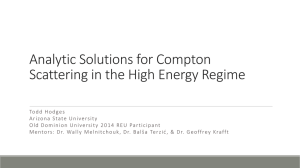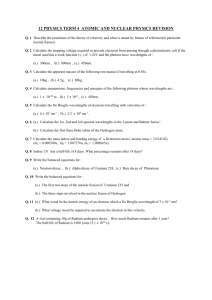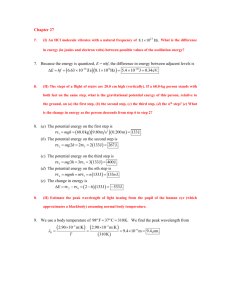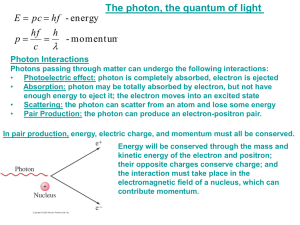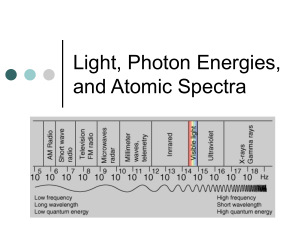Solution
advertisement
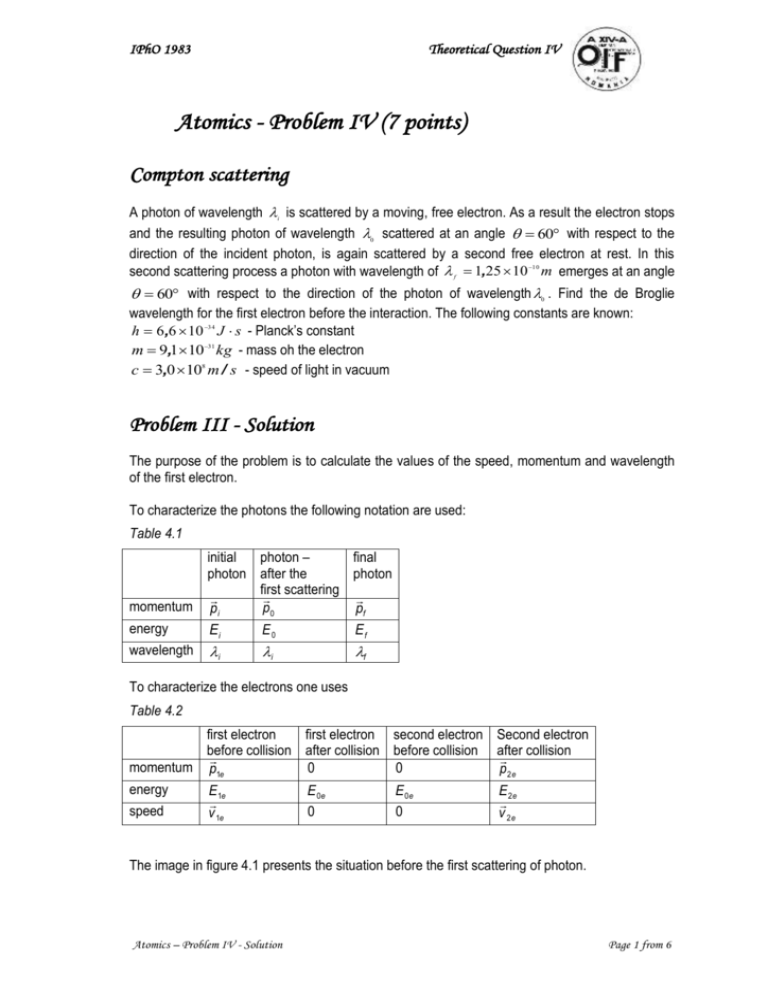
IPhO 1983 4. Theoretical Question IV Atomics - Problem IV (7 points) Compton scattering A photon of wavelength i is scattered by a moving, free electron. As a result the electron stops and the resulting photon of wavelength 0 scattered at an angle 60 with respect to the direction of the incident photon, is again scattered by a second free electron at rest. In this second scattering process a photon with wavelength of f 1,25 10 10 m emerges at an angle 60 with respect to the direction of the photon of wavelength . Find the de Broglie 0 wavelength for the first electron before the interaction. The following constants are known: h 6,6 10 3 4 J s - Planck’s constant m 9,11031 kg - mass oh the electron c 3,0 108 m / s - speed of light in vacuum Problem III - Solution The purpose of the problem is to calculate the values of the speed, momentum and wavelength of the first electron. To characterize the photons the following notation are used: Table 4.1 initial photon – final photon after the photon first scattering momentum p i p0 pf energy E0 Ei Ef wavelength i i f To characterize the electrons one uses Table 4.2 first electron first electron second electron Second electron before collision after collision before collision after collision momentum p1e 0 0 p2e energy E 0e E 0e E 2e E 1e speed 0 0 v 1e v 2e The image in figure 4.1 presents the situation before the first scattering of photon. Atomics – Problem IV - Solution Page 1 from 6 IPhO 1983 Figure 4.1 Figure 4.3 Theoretical Question IV Figure 4.2 Figure 4.4 To characterize the initial photon we will use his momentum p i and his energy E i h h fi Pi i c E h f i i fi c i is the frequency of initial photon. For initial, free electron in motion the momentum p oe and the energy E oe are m 0 v 1e Poe m v 1e 1 2 2 E m c 2 m 0 c oe 1 2 ( 4.1) ( 4.2) ( 4.3) where m 0 is the rest mass of electron and m is the mass of moving electron. As usual, v 1e . De Broglie wavelength of the first electron is c Atomics – Problem IV - Solution Page 2 from 6 IPhO 1983 Theoretical Question IV h h 1 2 p0e m 0 v 1e The situation after the scattering of photon is described in the figure 4.2. To characterize the scattered photon we will use his momentum p 0 and his energy E 0 oe h h fo Po o c E h f o o ( 4.4). where fo c ( 4.5) 0 is the frequency of scattered photon. The magnitude of momentum of the electron ( that remains in rest) after the scattering is zero; his energy is E 1e . The mass of electron after collision is m 0 - the rest mass of electron at rest. So, E1e m0 c 2 To determine the moment of the first moving electron, one can write the principles of conservation of moments and energy. That is Pi poe p0 ( 4.6) and ( 4.7) E i E 0e E 0 E1e The conservation of moment on Ox direction is written as h f0 h fi m v 1e cos cos c c ( 4.8) and the conservation of moment on Oy is m v 1e sin h f0 sin c ( 4.9) To eliminate , the last two equation must be written again as h2 2 f0 cos f i 2 m v cos 1e 2 c 2 m v sin 2 h f 0 sin 1e c ( 4.10) and then added. The result is m 2 v 12e h2 2 2 f 0 f1 2f 0 f i cos c2 ( 4.11) or Atomics – Problem IV - Solution Page 3 from 6 IPhO 1983 m 02 c 2 v 1 1e c 2 Theoretical Question IV v 12e h 2 f 02 f12 2f 0 f i cos ( 4.12) The conservation of energy (4.7) can be written again as m c 2 h f1 m 0 c 2 h f 0 ( 4.13) or m0 c 2 v 1 1e c 2 m 0 c 2 h f 0 f1 ( 4.14) Squaring the last relation results m 02 c 4 v 1 1e c m 02 c 4 h 2 f 0 f1 m 0 h c 2 f 0 f1 2 2 ( 4.15) Subtracting (4.12) from (4.15) the result is 2m 0 c 2 h f 0 f1 2h 2 f1 f 0 cos 2h 2 f1 f 0 ( 4.16) or h m0 c 1 cos c f1 c f0 ( 4.17) Using h m0 c ( 4.18) the relation (4.17) becomes 1 cos i 0 ( 4.19) The wavelength of scattered photon is 0 i 1 cos ( 4.20) shorter than the wavelength of initial photon and consequently the energy of scattered photon is greater that the energy of initial photon. i 0 E i E 0 ( 4.21) Let’s analyze now the second collision process that occurs in point N . To study that, let’s consider a new referential having Ox direction on the direction of the photon scattered after the first collision. Atomics – Problem IV - Solution Page 4 from 6 IPhO 1983 Theoretical Question IV The figure 4.3 presents the situation before the second collision and the figure 4.4 presents the situation after this scattering process. The conservation principle for moment in the scattering process gives h h cos m v 2e cos 0 f ( 4.22) h sin m v sin 0 2e f To eliminate the unknown angle must square and then add the equations (4.22) That is 2 h h cos m v 2e cos 2 0 f 2 h 2 sin m v 2e sin f ( 4.23) or h f 2 2 h 2h2 2 cos m v 2e 0 0 f ( 4.24) The conservation principle of energy in the second scattering process gives h c 0 m0 c 2 h c f m c2 ( 4.25) (4.24) and (4.25) gives h2 c2 2f h2 c2 20 2h2 c2 cos m 2 c 2 v 22e 0 f ( 4.26) and 2 1 1 1 1 h c m 02 c 4 2h c 3 m 0 m 2 c 4 f 0 f 0 2 2 ( 4.27) Subtracting (4.26) from (1.27), one obtain h 1 cos f 0 m 0 c 1 cos 0 f ( 4.28) That is f 0 E f E 0 Atomics – Problem IV - Solution ( 4.29) Page 5 from 6 IPhO 1983 Theoretical Question IV Because the value of f is know and can be calculate as f 1,25 10 10 m 6,6 10 34 m 2,41 10 12 m 0,02 10 10 m 31 8 9,1 10 3 10 ( 4.30) the value of wavelength of photon before the second scattering is 0 1,23 10 10 m ( 4.31) Comparing (4.28) written as: f 0 1 cos ( 4.32) and (4.20) written as i 0 1 cos ( 4.33) clearly results i f ( 4.34) The energy of the double scattered photon is the same as the energy of initial photon. The direction of “final photon” is the same as the direction of “initial” photon. Concluding, the final photon is identical with the initial photon. The result is expected because of the symmetry of the processes. Extending the symmetry analyze on electrons, the first moving electron that collides the initial photon and after that remains at rest, must have the same momentum and energy as the second electron after the collision – because this second electron is at rest before the collision. That is p1e p2e ( 4.35) E1e E 2e Taking into account (4.24), the moment of final electron is p2 e h 1 2 f 1 2 cos 2 f 1 cos f f 1 cos ( 4.36) The de Broglie wavelength of second electron after scattering (and of first electron before scattering) is 1 1 2 cos 2 2 f 1 cos f f 1 cos f 1e 2e 1 ( 4.37) Numerical value of this wavelength is 1e 2e 1,24 10 10 m ( 4.38) Professor Delia DAVIDESCU, National Department of Evaluation and Examination–Ministry of Education and Research- Bucharest, Romania Professor Adrian S.DAFINEI,PhD, Faculty of Physics – University of Bucharest, Romania Atomics – Problem IV - Solution Page 6 from 6



